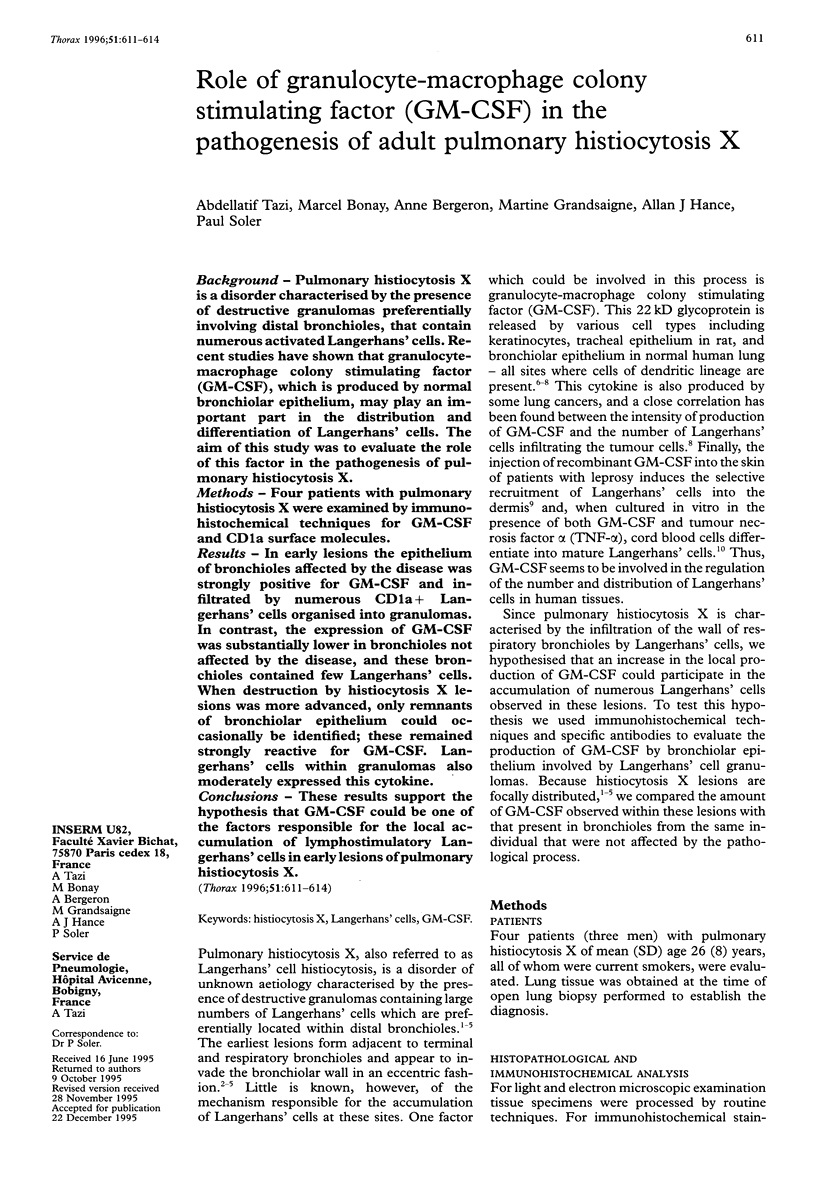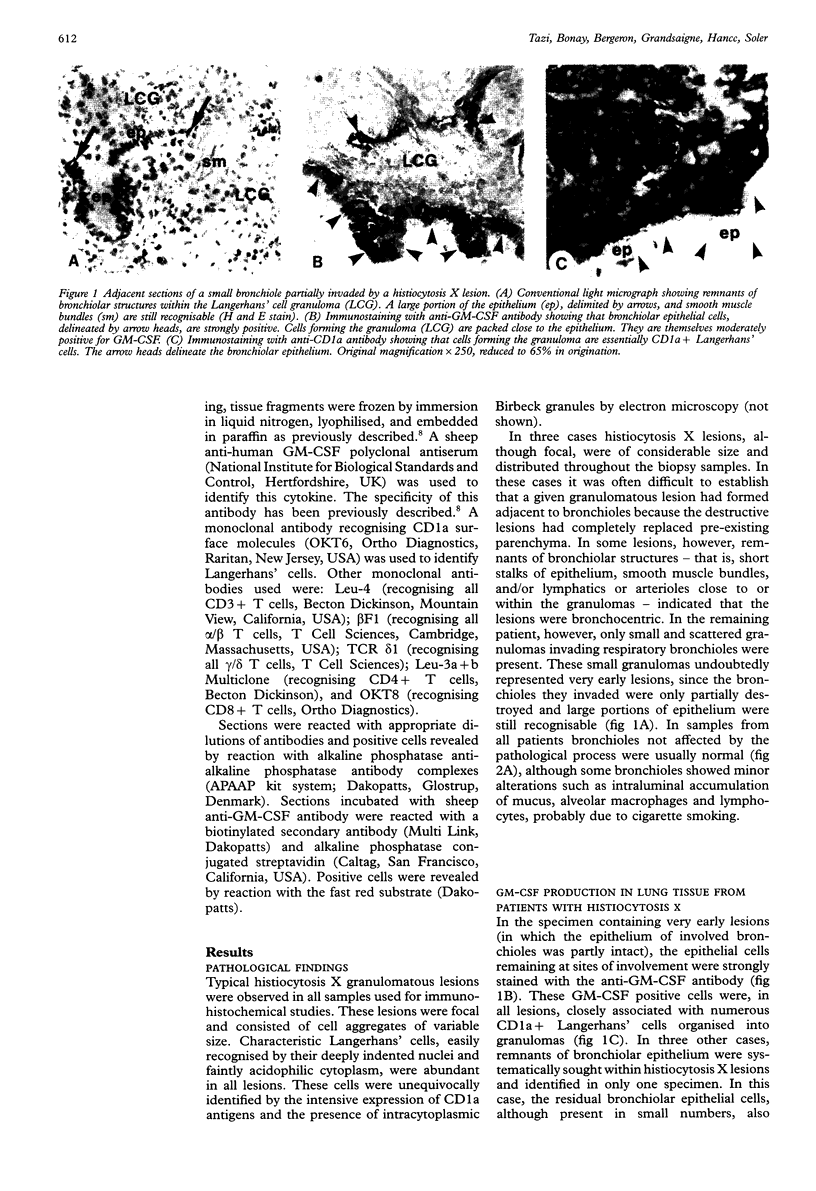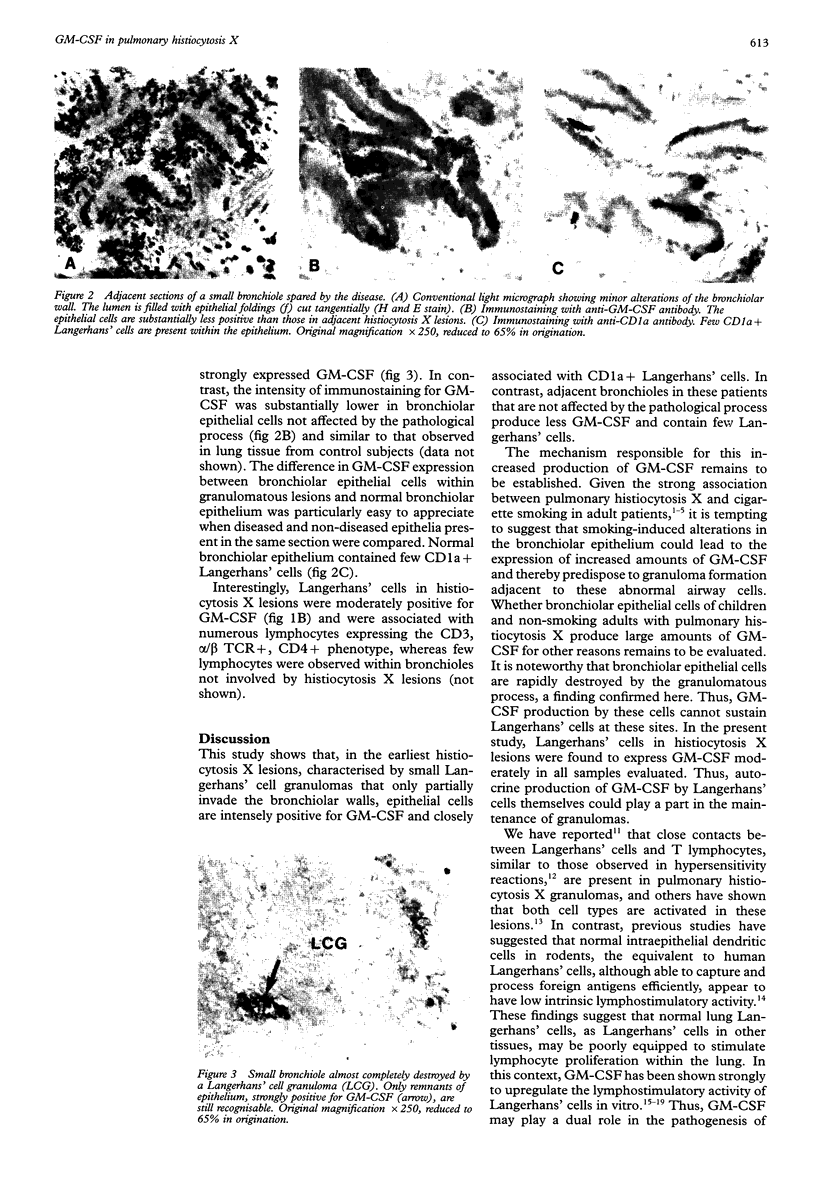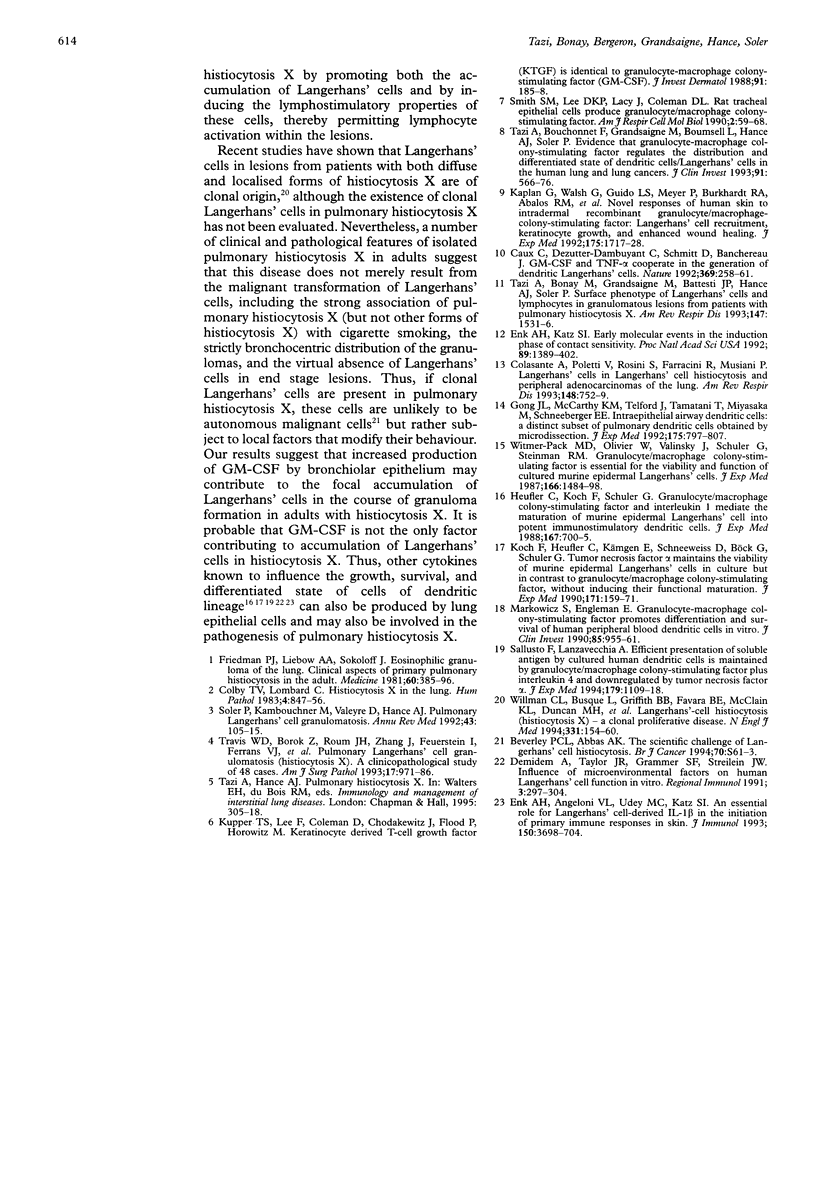Abstract
BACKGROUND: Pulmonary histiocytosis X is a disorder characterised by the presence of destructive granulomas preferentially involving distal bronchioles, that contain numerous activated Langerhans' cells. Recent studies have shown that granulocyte-macrophage colony stimulating factor (GM-CSF), which is produced by normal bronchiolar epithelium, may play an important part in the distribution and differentiation of Langerhans' cells. The aim of this study was to evaluate the role of this factor in the pathogenesis of pulmonary histiocytosis X. METHODS: Four patients with pulmonary histiocytosis X were examined by immunohistochemical techniques for GM-CSF and CD1a surface molecules. RESULTS: In early lesions the epithelium of bronchioles affected by the disease was strongly positive for GM-CSF and infiltrated by numerous CD1a+ Langerhans' cells organised into granulomas. In contrast, the expression of GM-CSF was substantially lower in bronchioles not affected by the disease, and these bronchioles contained few Langerhans' cells. When destruction by histiocytosis X lesions was more advanced, only remnants of bronchiolar epithelium could occasionally be identified; these remained strongly reactive for GM-CSF. Langerhans' cells within granulomas also moderately expressed this cytokine. CONCLUSIONS: These results support the hypothesis that GM-CSF could be one of the factors responsible for the local accumulation of lymphostimulatory Langerhans' cells in early lesions of pulmonary histiocytosis X.
Full text
PDF



Images in this article
Selected References
These references are in PubMed. This may not be the complete list of references from this article.
- Caux C., Dezutter-Dambuyant C., Schmitt D., Banchereau J. GM-CSF and TNF-alpha cooperate in the generation of dendritic Langerhans cells. Nature. 1992 Nov 19;360(6401):258–261. doi: 10.1038/360258a0. [DOI] [PubMed] [Google Scholar]
- Colasante A., Poletti V., Rosini S., Ferracini R., Musiani P. Langerhans cells in Langerhans cell histiocytosis and peripheral adenocarcinomas of the lung. Am Rev Respir Dis. 1993 Sep;148(3):752–759. doi: 10.1164/ajrccm/148.3.752. [DOI] [PubMed] [Google Scholar]
- Colby T. V., Lombard C. Histiocytosis X in the lung. Hum Pathol. 1983 Oct;14(10):847–856. doi: 10.1016/s0046-8177(83)80160-9. [DOI] [PubMed] [Google Scholar]
- Demidem A., Taylor J. R., Grammer S. F., Streilein J. W. Influence of microenvironmental factors on human Langerhans cell function in vitro. Reg Immunol. 1990;3(6):297–304. [PubMed] [Google Scholar]
- Enk A. H., Angeloni V. L., Udey M. C., Katz S. I. An essential role for Langerhans cell-derived IL-1 beta in the initiation of primary immune responses in skin. J Immunol. 1993 May 1;150(9):3698–3704. [PubMed] [Google Scholar]
- Friedman P. J., Liebow A. A., Sokoloff J. Eosinophilic granuloma of lung. Clinical aspects of primary histiocytosis in the adult. Medicine (Baltimore) 1981 Nov;60(6):385–396. [PubMed] [Google Scholar]
- Gong J. L., McCarthy K. M., Telford J., Tamatani T., Miyasaka M., Schneeberger E. E. Intraepithelial airway dendritic cells: a distinct subset of pulmonary dendritic cells obtained by microdissection. J Exp Med. 1992 Mar 1;175(3):797–807. doi: 10.1084/jem.175.3.797. [DOI] [PMC free article] [PubMed] [Google Scholar]
- Heufler C., Koch F., Schuler G. Granulocyte/macrophage colony-stimulating factor and interleukin 1 mediate the maturation of murine epidermal Langerhans cells into potent immunostimulatory dendritic cells. J Exp Med. 1988 Feb 1;167(2):700–705. doi: 10.1084/jem.167.2.700. [DOI] [PMC free article] [PubMed] [Google Scholar]
- Kaplan G., Walsh G., Guido L. S., Meyn P., Burkhardt R. A., Abalos R. M., Barker J., Frindt P. A., Fajardo T. T., Celona R. Novel responses of human skin to intradermal recombinant granulocyte/macrophage-colony-stimulating factor: Langerhans cell recruitment, keratinocyte growth, and enhanced wound healing. J Exp Med. 1992 Jun 1;175(6):1717–1728. doi: 10.1084/jem.175.6.1717. [DOI] [PMC free article] [PubMed] [Google Scholar]
- Koch F., Heufler C., Kämpgen E., Schneeweiss D., Böck G., Schuler G. Tumor necrosis factor alpha maintains the viability of murine epidermal Langerhans cells in culture, but in contrast to granulocyte/macrophage colony-stimulating factor, without inducing their functional maturation. J Exp Med. 1990 Jan 1;171(1):159–171. doi: 10.1084/jem.171.1.159. [DOI] [PMC free article] [PubMed] [Google Scholar]
- Kupper T. S., Lee F., Coleman D., Chodakewitz J., Flood P., Horowitz M. Keratinocyte derived T-cell growth factor (KTGF) is identical to granulocyte macrophage colony stimulating factor (GM-CSF). J Invest Dermatol. 1988 Aug;91(2):185–188. doi: 10.1111/1523-1747.ep12464470. [DOI] [PubMed] [Google Scholar]
- Markowicz S., Engleman E. G. Granulocyte-macrophage colony-stimulating factor promotes differentiation and survival of human peripheral blood dendritic cells in vitro. J Clin Invest. 1990 Mar;85(3):955–961. doi: 10.1172/JCI114525. [DOI] [PMC free article] [PubMed] [Google Scholar]
- Sallusto F., Lanzavecchia A. Efficient presentation of soluble antigen by cultured human dendritic cells is maintained by granulocyte/macrophage colony-stimulating factor plus interleukin 4 and downregulated by tumor necrosis factor alpha. J Exp Med. 1994 Apr 1;179(4):1109–1118. doi: 10.1084/jem.179.4.1109. [DOI] [PMC free article] [PubMed] [Google Scholar]
- Smith S. M., Lee D. K., Lacy J., Coleman D. L. Rat tracheal epithelial cells produce granulocyte/macrophage colony-stimulating factor. Am J Respir Cell Mol Biol. 1990 Jan;2(1):59–68. doi: 10.1165/ajrcmb/2.1.59. [DOI] [PubMed] [Google Scholar]
- Soler P., Kambouchner M., Valeyre D., Hance A. J. Pulmonary Langerhans' cell granulomatosis (histiocytosis X). Annu Rev Med. 1992;43:105–115. doi: 10.1146/annurev.me.43.020192.000541. [DOI] [PubMed] [Google Scholar]
- Tazi A., Bonay M., Grandsaigne M., Battesti J. P., Hance A. J., Soler P. Surface phenotype of Langerhans cells and lymphocytes in granulomatous lesions from patients with pulmonary histiocytosis X. Am Rev Respir Dis. 1993 Jun;147(6 Pt 1):1531–1536. doi: 10.1164/ajrccm/147.6_Pt_1.1531. [DOI] [PubMed] [Google Scholar]
- Tazi A., Bouchonnet F., Grandsaigne M., Boumsell L., Hance A. J., Soler P. Evidence that granulocyte macrophage-colony-stimulating factor regulates the distribution and differentiated state of dendritic cells/Langerhans cells in human lung and lung cancers. J Clin Invest. 1993 Feb;91(2):566–576. doi: 10.1172/JCI116236. [DOI] [PMC free article] [PubMed] [Google Scholar]
- Travis W. D., Borok Z., Roum J. H., Zhang J., Feuerstein I., Ferrans V. J., Crystal R. G. Pulmonary Langerhans cell granulomatosis (histiocytosis X). A clinicopathologic study of 48 cases. Am J Surg Pathol. 1993 Oct;17(10):971–986. doi: 10.1097/00000478-199310000-00002. [DOI] [PubMed] [Google Scholar]
- Willman C. L., Busque L., Griffith B. B., Favara B. E., McClain K. L., Duncan M. H., Gilliland D. G. Langerhans'-cell histiocytosis (histiocytosis X)--a clonal proliferative disease. N Engl J Med. 1994 Jul 21;331(3):154–160. doi: 10.1056/NEJM199407213310303. [DOI] [PubMed] [Google Scholar]
- Witmer-Pack M. D., Olivier W., Valinsky J., Schuler G., Steinman R. M. Granulocyte/macrophage colony-stimulating factor is essential for the viability and function of cultured murine epidermal Langerhans cells. J Exp Med. 1987 Nov 1;166(5):1484–1498. doi: 10.1084/jem.166.5.1484. [DOI] [PMC free article] [PubMed] [Google Scholar]





